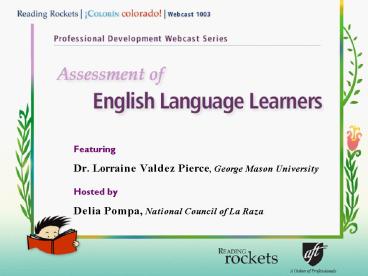Characteristics of English Language Learners ELLs - PowerPoint PPT Presentation
1 / 33
Title:
Characteristics of English Language Learners ELLs
Description:
One size does not fit all. English language standardized tests not ... Checklists detailing learning expectations. Assessing ELLs with. Learning Disabilities ... – PowerPoint PPT presentation
Number of Views:842
Avg rating:3.0/5.0
Title: Characteristics of English Language Learners ELLs
1
(No Transcript)
2
Characteristics of English Language Learners
(ELLs)
- Language
- Similarities differences
- Culture
- Childrearing practices family values
- Parental role in school
- Previous educational experience
- Literacy in native language
3
Characteristics of ELLs
- Language
- Over 200 language backgrounds
- Proximity of native language to English
- Culture
- Passive vs. active
- Family values
- Child-rearing practices
- Previous educational experience
- Use of native language literacy as a building
block
4
What is Assessment?
- Gathering information on what a student knows or
has learned - Formal or informal
- Observation documentation
5
No Child Left Behind
- Good News
- Accountability for ELLs
- Bad News
- One size does not fit all
- English language standardized tests not always
appropriate for ELLs - Statewide testing for ELLs an emerging field,
not much research
6
Disaggregation of Test Scores
- Separating out test scores or results for ELL
students from all scores - To find out
- How are ELLs doing?
- Are they meeting state standards?
7
Validity
- Accuracy of inferences
- Making appropriate assumptions about test scores
- Use language of classroom instruction
- Use alternative forms of assessment that reflect
classroom instruction
8
Video
- New Kid in Town
- Arlington Intake Center, Arlington VA
9
Newcomer Assessment
- Used to determine
- Native language literacy
- Prior educational experience
- Phonemic awareness in English
- Prior knowledge
10
Inappropriate Assessments
- Problems with current tests
- Heavy language load
- Out of context
- Culturally-based
11
Sample Test Item
- Grade 3 Reading
- Look at the picture.
- Which word has the same middle and ending sounds
as the name of the picture? - F butter
- G rabbit
- H kettle
- J nibble
12
Assessing Reading
- Must reflect classroom instruction
- Use interactive tasks to provide context for
learning - Standardized tests do not always provide context
or language support
13
Linking Classroom Assessments to Statewide Tests
- Base classroom assessments on state standards
- Use classroom learning tasks as opportunities for
assessment
14
Benefits of Classroom-Based Assessments
- Guide both teaching learning
- Continuous adjustments by teacher students
- Provide specific, personalized, timely information
15
Two Types of Assessment
- Teacher-Useful Assessments
- Observation documentation
- Checklists, rubrics, anecdotal records
- Student-Friendly Assessments
- Checklists detailing learning expectations
16
Assessing ELLs withLearning Disabilities
- Ways to promote success
- Use manipulatives, pictures, illustrations
- Use performance-based assessment
- Use instructionally-based materials
17
Language or Learning Disability?
- Ways to assess
- Educational medical history
- Parental interview
- Student interview
- Teacher observation and documentation on variety
of learning tasks
18
Assessment
An integral part of instruction
- Does not need to take time away from instruction
- Can be simultaneous to instruction
- Must be ongoing continuous
- Can provide feedback to guide teaching and
improve learning
19
Needs/Diagnostic Assessment
Cycle of Assessment Instruction
Redirected Reading Instruction
Reading Instruction
Teacher Assessments Inform Direct Instruction
20
Before and After Teaching
- Find out what students know
- Diagnostic tests
- Oral questioning
- Group for differentiated instruction
- Relate to prior knowledge students interests
- Compare results before and after tests
21
State Standardized Tests
- Measure annual growth
- Not as useful for informing classroom instruction
on weekly basis
22
Video
- Letters and Sounds
- Mark Hopkins Elementary School, Sacramento CA
23
Video highlights
- Student engaged to follow specific instruction
- Student performs literacy task
- Teacher keeps record of strengths and needs
24
Useful Teaching Approaches
- Relate new information to students prior
knowledge - Use hands-on tasks, manipulatives, games,
kinesthetic activities, visuals - Help learners feel they belong
25
Assessing and DiagnosingIn a Multi-lingual
Classroom
- Common set of teaching standards and objectives
- Compare each students accomplishments to
standards instead of to each other
26
When Native Language LiteracyIs Not Available in
the Classroom
- Gather Resources
- Parents, community members, networking
- Provide Scaffolding in the Classroom
- Simplified English language
- Reinforce oral directions with written ones
- Visuals, manipulatives
- Cooperative learning, games
- Reduce students anxiety stress
27
Assessment That Promotes Learning
- Not just auditing learning
- Diagnosing strengths and needs
- Providing specific feedback
- Descriptive productive feedback
- Not just a grade
- Add constructive comments
28
Sharing Expectations with Students
Essential for self-monitoring
- Ideas to try
- Use wall charts, tables, graphs
- Use symbols to reduce language load
- Use color coding
- Use student-friendly checklists for reading
skills - Student/teacher conferences
29
Informing Both Parents Students
- Share learning goals, objectives, and assessment
results - Enable students to hit the learning target
30
Teacher Observations
- Observe whole class or small groups
- Save one-on-one assessment for individuals not
making progress - Group individual tasks
- Provide time for individual conferences
31
Involving Parents
- Native language resources
- Provide childs history
- Need to know learning goals assessment
expectations - Can support literacy in the home
32
Summary
- Need variety of assessments
- Need to involve parents
- Need state legislation requiring teacher
assessment literacy
33
Thank you for watching!































